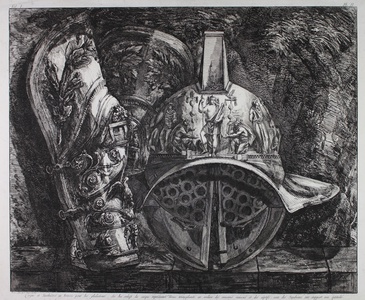| Method | Etching |
| Artist | Francesco Piranesi |
| Published | Dessine et grave par F. Piranesi L'an 1806. |
| Dimensions | Image 610 x 735 mm, Plate 635 x 835 mm, Sheet 645 x 850 mm |
| Notes |
A very large etching of a gladiatorial helmet and greaves, from Francesco Piranesi's Usages Civils et Militaires trouves a Pompeia et a Herculanum, the third volume of his Antiquités de la Grande Grèce. The plate is one of the most imposing and visually impressive of the series, showcasing one of the most significant finds from the ruins of Pompeii. The bronze helmet and greaves are now in the collection of the Naples Archaeological Museum. The helmet, of the type used by murmillo and Samnite gladiators, features illustrations of victory, including bound captives and supplicating barbarians, above its broad brim and below the plume mount, while a split full visor features circular openings. The greaves are likewise highly ornate, with theatrical masks, eagles, oak chaplets, and vines. An inscription after the title reads: Les bas reliefs du casque representent Rome triomphante au milieu des ennemis vaincus et des captifs; ceux des Jambieres ont rapport aux Spectacles. The Antiquités de la Grande Grèce was published in the early years of the nineteenth century, but was most likely inspired by two visits to Paestum, Pompeii, and Herculaneum undertaken by Francesco Piranesi with his father in 1770 and 1778. Giovanni Battista Piranesi had prepared a number of preparatory sketches of the temples of Pompeii and Paestum that were eventually engraved and published by Francesco, but the remaining plates for the three volumes of the Antiquités seem to have been of Francesco's invention. Although lacking some of the romanticism of his father's earlier plates of Rome, the illustrations from the Antiquités nevertheless provide a valuable record of progress in the archaeological exploration of the sites of the Neapolitan region, and are testament to Francesco's deep engagement with Roman antiquity. Francesco Piranesi (c.1756-1810) was an Italian engraver, etcher and architect who mainly worked in Paris. He was the eldest son of the famous etcher Giovanni Battista Piranesi (1720-1778), under whom he studied printmaking and architecture. By 1775, Piranesi was both producing his own work and assisting with his father's. Upon the death of Giovanni Piranesi three years later, he inherited his father's publishing house and was responsible for producing most of the later editions of his prints. In 1798, Piranesi moved to Paris, where he was later employed by Napolean, to engrave classical sculpture and vase collections within France and French-occupied Italy. He also collaborated with the French artist Louis-Jean Desprez (c.1743-1804) on a series of Italian views which were sold at Piranesi's shop in Rome. Although the 1783 advertisement for the series promised forty-eight views, the series was not completed before Desprez left Rome to become Director of Scenic Decorations at the Stockholm Opera. Piranesi died in Paris from syphilis in 1810. Condition: Trimmed to platemark at top and bottom. Marginal creasing and ink-staining. Repaired tears to edges of sheet, particularly to inscription space. |
| Framing | unmounted |
| Price | £2,250.00 |
| Stock ID | 50725 |

